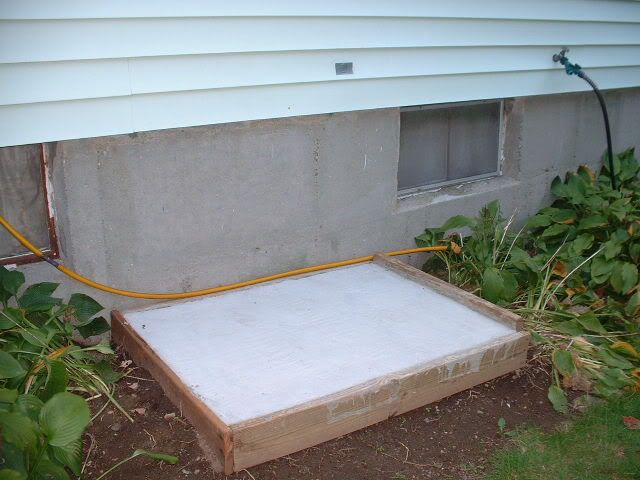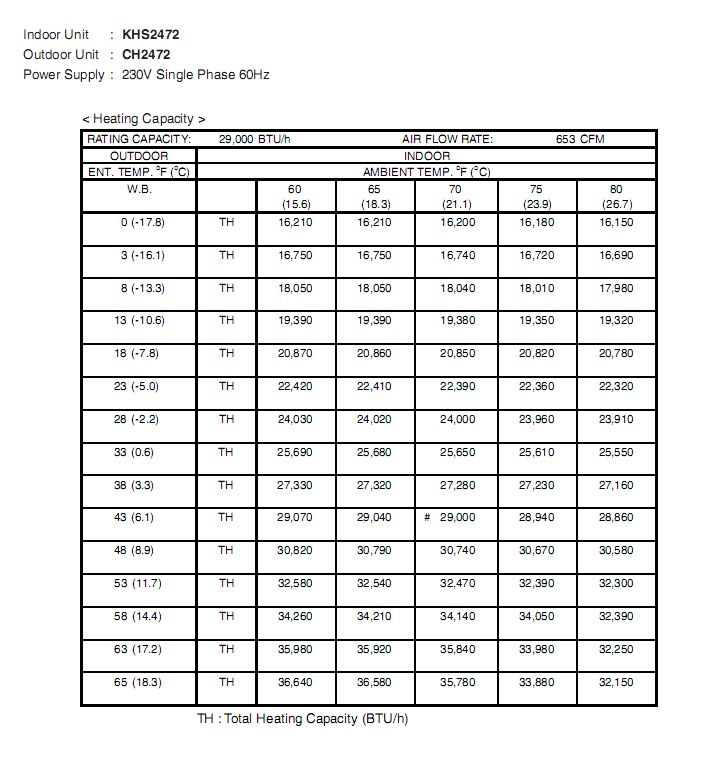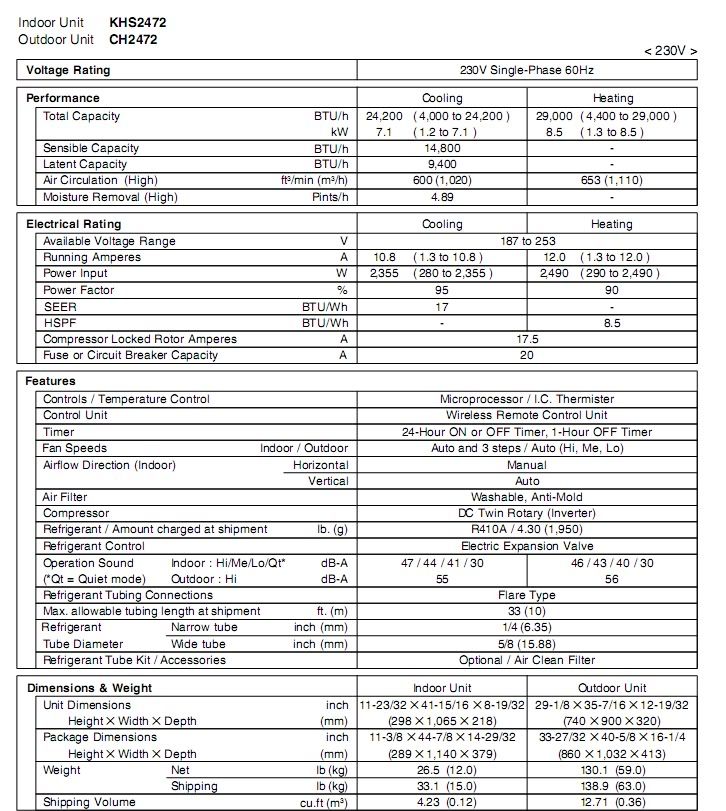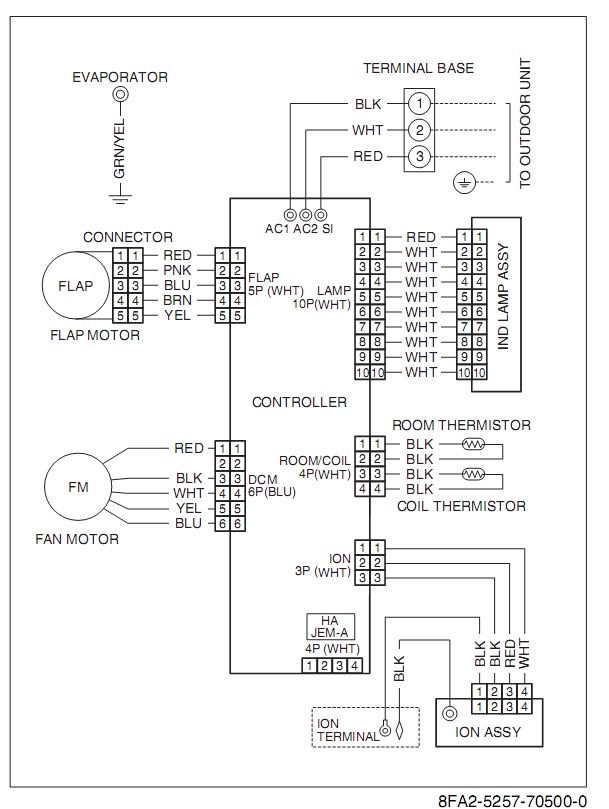
 |
|
|
#1 |
|
Lex Parsimoniae
Join Date: Feb 2009
Location: Woburn, MA
Posts: 4,918
Thanks: 114
Thanked 250 Times in 230 Posts
|
I've been reading about this gizmo for about a year now, and I'm impressed.
24KHS72 - Sanyo 24,200 BTU Heat Pump Air Conditioner Kit I've placed my order and it should be here in a few weeks. In the mean time, I need to get ready with some tools and education. I've already picked out the location for the outdoor unit and built the pad. Moved the water tap down the wall a few feet, leaving a nice hole for the 230VAC power.  As you can see from this chart: Woburn Weather - Massachusetts - Average Temperatures and Rainfall The mean temperature is only 25 deg F. during our coldest month of the year. So, if this thing will put out adequate BTUhs of heat when it's 17degs out, we should be warm as toast this winter.  (They say, it will do 70% at Zero degrees F. That's 20,300 BTUh)! I'm going find out if this is true, if it gets that cold this winter! I'll post more as I go along. Cheers, Rich Edit: Adding informative charts.   Here's the 'After' picture.. So you won't have to read all these pages..   Flow chart:  Inside unit:  Outdoor unit:  Last edited by Xringer; 11-28-09 at 01:46 PM.. Reason: Adding chart.. and now some pics of diagrams |
|
|

|
| The Following User Says Thank You to Xringer For This Useful Post: | CudaNet (10-31-13) |
|
|
#2 |
|
Lex Parsimoniae
Join Date: Feb 2009
Location: Woburn, MA
Posts: 4,918
Thanks: 114
Thanked 250 Times in 230 Posts
|
I found this page a while back.. It has lot of pictures
MINI SPLIT INSTALLATION GUIDE - KINGERSONS.COM That depict the basic Mini-Split install. This will be used with the Sanyo install manual to give me a better idea of what this job entails. |
|
|

|
|
|
#3 |
|
Administrator
Join Date: Aug 2008
Location: Germantown, WI
Posts: 5,525
Thanks: 1,162
Thanked 374 Times in 305 Posts
|
Very cool! I see the COP is rated at 3.4. Not too shabby.
I have a question about the placement of the unit. Where is it in relation to the house? North side of your house out of the sun? South side for better heating in the winter?
__________________
Current project - To view links or images in signatures your post count must be 0 or greater. You currently have 0 posts. To view links or images in signatures your post count must be 0 or greater. You currently have 0 posts. & To view links or images in signatures your post count must be 0 or greater. You currently have 0 posts. Last edited by Daox; 10-03-09 at 08:15 PM.. |
|
|

|
|
|
#4 | |
|
Lex Parsimoniae
Join Date: Feb 2009
Location: Woburn, MA
Posts: 4,918
Thanks: 114
Thanked 250 Times in 230 Posts
|
Quote:
from the house. So, the compressor unit will be about 8 feet from the garage, which is blocking most of the early morning sun. The sun is going to hit the pad between (approx) 9:30 & 11:30 AM. (9:30 AM, that's about the time old retired guys want to call for heat)..  As a side project, I've purchased some 1.25" PVC pipe (40 feet). The pipe will be used to build a support for a small snow roof for the outdoor unit. It's job will be to keep snow fall from building up on the 3x4' pad. Since it's going to be a portable (it will look like a table with a sloped top), I might be able to use it as a sun shield during the summer cooling months.. However, there are very few summer days around here when we use the AC until afternoon, When the east side is out of the sun. |
|
|
|

|
|
|
#5 |
|
Lex Parsimoniae
Join Date: Feb 2009
Location: Woburn, MA
Posts: 4,918
Thanks: 114
Thanked 250 Times in 230 Posts
|
I recall looking at that COP number when I was researching around.
http://www.ci.richland.wa.us/RICHLAN...s%20041009.xls According to what I've found, the COP is 3.4 when you are running it full bore. 29,000 BTUh, burning 2,490 watts gives you a 3.4 COP. But, after things have warmed up and the unit is just coasting along at, say, 4,400 BTU, only burning 290 watts, you get a COP of 4.4  Maybe it's good this thing is a tad over-sized.?. We have added a bunch of insulation in the past year, and I'm really looking forward to seeing if I can actually heat my home using 290 watts!! LOL!! At least on the mild days.. Last edited by Xringer; 10-31-09 at 10:26 PM.. Reason: spellin errors |
|
|

|
|
|
#6 |
|
Supreme EcoRenovator
Join Date: Mar 2009
Location: Portland, OR
Posts: 4,004
Thanks: 303
Thanked 724 Times in 534 Posts
|
Good luck with your new unit.
I bought a 9,000 BTU version (12,000 BTU heating) of the Sanyo last year, to carry me through my GSHP project. The unit I got has a lower HSPF rating than yours, but still it really works great. Most of the time, I can't even tell that it's running. The thermostat is very accurate. You set it for the temperature you want, like 68 for instance, and the house goes to 68 and stays there, no temperature swings like my central air gas furnace did. Most comfortable heat I've ever had. Best regards, -AC_Hacker Last edited by AC_Hacker; 10-04-09 at 12:04 AM.. |
|
|

|
| The Following User Says Thank You to AC_Hacker For This Useful Post: | CudaNet (10-31-13) |
|
|
#7 |
|
Lex Parsimoniae
Join Date: Feb 2009
Location: Woburn, MA
Posts: 4,918
Thanks: 114
Thanked 250 Times in 230 Posts
|
From what I've been able to glean, Sanyo is one of the better brand names (for ductless).
And, I was able to get very familiar with the Sanyo 24KLS72 AC-only unit that we had installed at work. It's a super AC and like you said, 'can't even tell that it's running'.. After 30+ years of waking up to the baseboard pipes pinging at night, on our forced-hot-water-by-oil system, a reduction in noise level is most welcome! ~~~ The 20' line-set that comes with the kit I'm getting might be a bit too long. I found out that the minimum length is 10', so I'm thinking about cutting them down to around 13 to 16 feet on install day. After seeing the very poor job our HVAC guys at work did on the 24KLS72 line-set install, I'm thinking of buying my own Sears flare tool and DIY. Sears.com I see the manual refers to a 'special R410A flare tool' and "RIGID", but there just isn't enough info about which tool I need. Sears has a bunch of them, but I need some tips on what to look for.. Thanks, Rich Edit: It seems I will need a 37 degree flare kit.?. Summit SUM-900311 - Summit Racing® 37 Degree Flare Tool Sets - Overview - SummitRacing.com Not too cheap looking. Everything else I found cost way too much. I saw where one guy converted his 45 deg to a 37 deg in his shop.. Last edited by Xringer; 10-04-09 at 10:49 AM.. |
|
|

|
|
|
#8 | |
|
Supreme EcoRenovator
Join Date: Mar 2009
Location: Portland, OR
Posts: 4,004
Thanks: 303
Thanked 724 Times in 534 Posts
|
Quote:
As a disclaimer: (* I am not a refrigeration technician. If you do the work yourself, you're voiding your warantee. *) But I did mine myself and it's working just great. I didn't change my lineset, so you will need to verify that the R-410a flare fitting is not substantially different from other flare fittings. I do think it has a different diameter but you should still be able to use common flare tools. Will you be doing the entire install yourself? I installed mine, and I can tell you what I did, if you are interested... Regards, -AC_Hacker |
|
|
|

|
|
|
#9 | |
|
Lex Parsimoniae
Join Date: Feb 2009
Location: Woburn, MA
Posts: 4,918
Thanks: 114
Thanked 250 Times in 230 Posts
|
Quote:
I won't be doing the whole install, but I want to do most of it. This week, I'll be talking to the city inspector to get permission to do my own 230vac wiring. (I was allowed to wire up the addition we added to our home about 20 years back, including the 230 outlet). I would also like to install and test the line-set tubing. Which does not look very hard to do. I just wonder if I buy the tools (vac pump & R410A gauge set) will I ever use those tools more than once..  But, since I plan to call in a certified AC guy to release the R410A, for the warranty sign-off. I'm wondering if I should skip testing the line-set and just let him do it.?. YES, I am very interested in every step of your install.. Did you take any pics?  Thanks, Rich |
|
|
|

|
|
|
#10 | |||
|
Supreme EcoRenovator
Join Date: Mar 2009
Location: Portland, OR
Posts: 4,004
Thanks: 303
Thanked 724 Times in 534 Posts
|
Quote:
On the other hand, you might get inspired, even empowered, and hack all kinds of stuff. ... 'course, you could sell the stuff on ebay. BTW, if you're going to test your line set, I think you'd be better with a micron gauge than an R-410a gauge. What you'd do is to pump a good deep vacuum, like maybe sub-100 microns and see how well it holds over night. If, the next day your vacuum is maybe 90 to 120 microns, you're OK. If it's in the range of 700-2000 microns, you got some 'splaining to do. Quote:
Quote:
So first, while at the freight pick-up place, I visually checked the shipping cartons to see if there was significant damage. There was not any, so I accepted the shipment and signed for it. (It's much easier to reject the shipment at the freight depot) Second, I got the beast home, and opened the boxed to check for internal damage. Everything checked out ok with the minor exception that there was a very minor crack in the plastic fan cover which I decided I could live with. I also went over the manifest to see that I had received everything I was supposed to receive. I read all the instructions several times until I was satisfied that I understood everything I needed to do. You'll need to drill a hole in the wall about 3" in diameter, and some forethought is called for. The indoor unit can have the lines dress in several different directions. I decided that coming straight out the back right side seemed to be the most logical. I had a site planned above a window that would have been quite unobtrusive, but there was a wall stud that prevented the desired placement of the unit. My house is small and old and after much consideration, I found a location that wasn't my first choice, but works well. There's a metal plate that needs to be mounted it will carry the indoor unit. For condensed water to flow out through the drain tube, the metal plate, and thus the whole indoor unit needs to be leveled properly. I aginize over the mounting, not wanting any rattles when the unit operated, but there is virtually no vibration when the indoor unit is running, so my agonizing was misplaced. There is a plastic tube through which the refrigerant tubes, the wire which communicates with the outdoor unit and the drain tube run. There's a jumbo plastic nut thingie that cinches it all down. Pretty neat, really. So you hook up the wires, as per the instruction book, and run the copper lines, the wire and the drain tube out through the wall, and 'hang' the inside unit on the hooks that are part of the sheet metal. I think I got a bit worked up trying to make all this happen as it should, and it wasn't working and I was lifting and trying, and sweat was running out of my arm pits and down my sides, when the whole thing just 'thunked' right into place exactly as it was supposed to. Everything lined up perfectly. I installed my little electric box outside, near the spot where the electric lines from the unit would most easily dress. My power was 120V because my unit was only 9,000 BTU. I verified my work at the master breaker box and at the box at the heat pump, then powered up just the box and assured that live,neutral and ground were where they belonged. All good. There is a LRA rating of the compressor. LRA is an abbreviation of Locked Rotor Amps. It refers to the worst case of the compressor when the rotor is frozen and there is power to the the compressor. In this case, the breaker MUST NOT be rated higher than the LRA. The breaker also needs to be high enough to allow normal operation and start-up current peaks. Your instructions will make this simple for you by specifying the proper breaker rating. Don't use this breaker for anything other than you heat pump. I located the outdoor unit where I wanted it, connected the wires from the heat pump electric box to the heat pump (breaker in "OFF" position, of course). I also hooked up the wires from the indoor unit as per the manual. I used di-electric grease on the terminals and connectors, since it's gonna be outside. With regards to ester oil on flare fittings, I used some stuff recommended by a local HVAC supply store, for HVAC assembly, they all refer to as 'snot'. I verified that it was compatible with R-410a. I think that ester oil (verify compatibility) would be just fine. My manual had torque specs for the flare fittings. The manual I downloaded did not have torque specs. I went with the torque specs. I used flare wrenches where possible but needed to make a special wrench head to use with my torque wrench. Here's a photo: It's ugly, but worked very well. I made sure that I hit the torque specs given in the manual that came with the unit. The amount of force required to hit the specs was more than I had anticipated. I even let it rest for a few hours and went back to verify I had enough torque, everything was good. The next stage is the pump down. You should have the proper gauges, including a micron gauge, and do a test pump with your equipment before you start to make sure everything is working well. >>>>>>>>>>>>>>>>>>>>>>>>>>>>>>>>>>>>>>>>>>>>>>> Make sure you put NEW VACUUM PUMP OIL in your vacuum pump right before you use it, as it is purposely hygroscopic and can quickly absorb atmospheric water. >>>>>>>>>>>>>>>>>>>>>>>>>>>>>>>>>>>>>>>>>>>>>>> So then I hooked up my manifold gauge set (with Bourdon type gauges as you pictured) and my vacuum pump and pumped it down. I didn't have my micron gauge yet so I was flying blind. I let it run for two hours to assure the best vacuum I could get. At this point, I didn't know how much vacuum I really had because the Bourdon gauges do not read down to the low vacuum levels where you need them to indicate small changes. Several weeks later, after I got my micron gauge, I did a mock-up of my pump-down setup, using the same equipment (except fo the heat pump) and NEW OIL and ran it again for the same time. I am happy to say that the vacuum I pulled was in the neighborhood of 80 microns, and quite good enough. But that was the first time I really knew that I had done it right. Not a good way to go. But you really need to know your real vacuum when you are doing the real pump-down. This should not be a faith-based situation! So, after I did the pump down, I followed the instructions per the manual, admitted a small amount of R-410a and checked with soap bubbles. Then admitted the full R-410a load, used 'snot' in the valve covers, and tightened them down and tested. Everything good. On hindsight, there were procedures where I agonized too much, like the indoor unit wall mounting bracket. There were also other areas where I should have agonized a bit more, like the pump down. On the pump-down, I was lucky. If I had the micron gauge when I was doing the pump-down I would have been certain. Certain is better than lucky. Best Regards, -AC_Hacker Last edited by AC_Hacker; 10-05-09 at 04:00 AM.. |
|||
|
|

|
 |
| Tags |
| air conditioner, diy, heat pump |
|
|